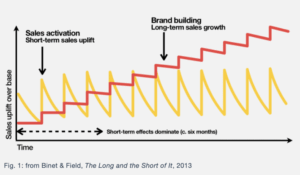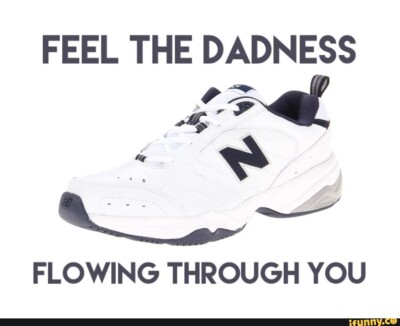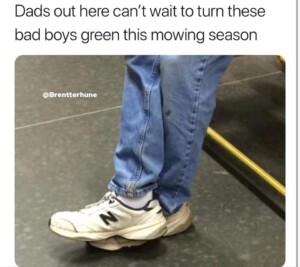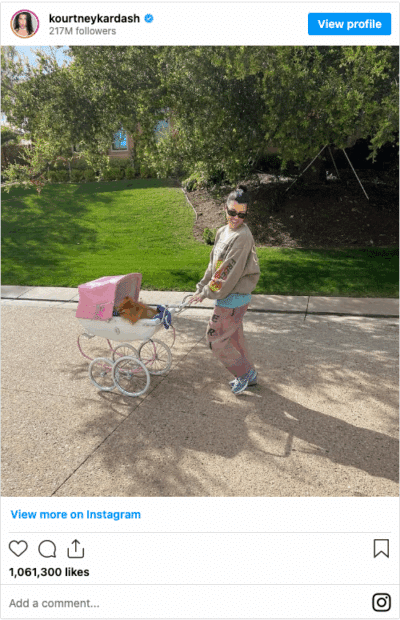
 Looking at tidy charts showing the necessity of long-term branding for long-term growth, you might end up thinking:
Looking at tidy charts showing the necessity of long-term branding for long-term growth, you might end up thinking:
“Cool story, bro, but where’s the real-world examples?”
And as your humble scribe, I’m bringing you just such a real-world case study.
Understand, though, that the tidy charts themselves are real-world data-driven, being the result of thousands of case studies compiled over decades. Still, one more example can’t hurt, so here goes:

New Balance Shoes. You probably know them as the classic “Dad Sneaker” — and that was the problem.
 See, back in the day, New Balance was a runner’s shoe, with serious running-shoe tech and cred.
See, back in the day, New Balance was a runner’s shoe, with serious running-shoe tech and cred.
In 1982, they launched the original 990 — the first sneaker ever to retail for $100 (roughly $330 in 2025 money), featuring cutting-edge tech, including a patented Motion Control Device for exceptional flexibility and support.
And New Balance remained popular throughout the‘ 80s and ‘90s, focused on making the best running shoes on the market. Crafted for function, not flash
But that substance-over-style ethos eventually turned New Balance into the “Dad Shoe” — comfy, durable, and zero sex appeal.
Sure, New Balance continued to have enthusiasts in the running community, and, yes, Steve Jobs wore them, but he was the celebrity exception that proved the rule.

When a guy famous for wearing the same outfit all the time in a “not caring about fashion IS my fashion” stance, having your shoes as part of that self-styled uniform ain’t necessarily a good thing.
Hell, New Balance was so associated with that attitude, writers even started using the brand as an adjective. As one pundit wrote:
“He is a proper New Balance American. A Home Depot constitutionalist. An Old Spice patriarch. Applebee’s federalist. Defender of Denny’s. Guardian of Golden Retrievers.”
And this is why New Balance saw a 15-year continuous sales decline from 2005 to 2020 — because the wrong associations can kill a brand as surely as the right ones can grow it.
So what did marketing do during that time?
They leaned heavily on performance marketing, aka, Sales Activation.
It’s common-sense but deadly reaction: sales are off, so let’s double down on Sales Activation to pump up the numbers.
By the time they brought in a new CMO in 2020, New Balance was spending 70% of their marketing dollars on sales activation and only 30% on brand building.
And the first thing that the new CMO did was flip the script: he began investing 70% of the marketing budget into brand building and only 30% into sales activation.
Granted, lots of it went into creative collaborations, influencers, and social media campaigns, but it was all brand-focused with a heavy emphasis on storytelling.

“The transformational shift that [New Balance] had was leading with the story versus leading with the product.”
– New Balance CMO, Chris Davis
Chris Davis, the new CMO, knew that they HAD to change perceptions of the sneaker before they could drive more growth. Hence the collaborations.
If the goal is to get people who do care about fashion to want your sneaker, you not only have to create a fashionable product, you have to also create the right associations in the sneaker-buying public.
Collaborations addressed both areas: associating the sneaker with fashionable designers and pop-culture celebrities while leveraging outside talent to help craft fashion-driven takes on classic New Balance models.
View this post on Instagram
View this post on Instagram

But the turnaround didn’t happen overnight. In fact, sales continued to slide for the next 18 months!
Fortunately, Davis had his finger on the pulse of the market and saw good things happening from the brand work his team was doing. And those leading indicators of brand-building traction helped him stay the course when other CMOs would have abandoned ship.
Then the magic happened.
Sales spiked in the second half of 2021, and New Balance recorded the most profitable and highest-revenue year in their history.
And it wasn’t a short-term spike, either. Sales and revenues continued to grow, with revenues doubling overall from 2020 to 2024.
So while this wasn’t a textbook case of Brand Building outperforming Sales Activation by month 7 of the campaign, it absolutely re-affirms the data-driven understanding that long-term brand building is non-negotiable for long-term growth.
Convinced? Want help with your long-term brand building? Reach out for a free 90-minute Brand Mojo Measurement.
- Getting a Foot in the Door — Of Perception - November 27, 2025
- What Digital Superstars Know About Offline Advertising - November 17, 2025
- Unmistakable: A Tale of Two Boots and Branding Done Right - November 8, 2025
